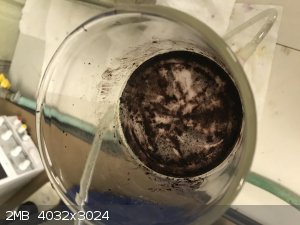Lion850
National Hazard
   
Posts: 514
Registered: 7-10-2019
Location: Australia
Member Is Offline
Mood: Great
|
|
Removing cobalt ferricyanide from Büchner funnel plate
Looking for advice on how to clean cobalt ferricyanide from the porous plate of my Büchner funnel. Usually I clean the funnel with concentrated
hydrochloric acid but as far as I know using strong acids with ferricyanide may lead to formation of cyanide gas. Thanks in advance.

|
|
|
symboom
International Hazard
    
Posts: 1143
Registered: 11-11-2010
Location: Wrongplanet
Member Is Offline
Mood: Doing science while it is still legal since 2010
|
|
Only thing I can think of is to oxidize it with Hydrogen peroxide or bleach to form cyanate from ferricyanide in alkaline environment
[Edited on 21-8-2020 by symboom]
|
|
|
Bedlasky
International Hazard
    
Posts: 1219
Registered: 15-4-2019
Location: Period 5, group 6
Member Is Offline
Mood: Volatile
|
|
Try concentrated ammonia - cobalt forms soluble hexaammine complex.
|
|
|
macckone
International Hazard
    
Posts: 2159
Registered: 1-3-2013
Location: Over a mile high
Member Is Offline
Mood: Electrical
|
|
Approved methods in industry in attached pdf.
Hydrogen peroxide requires a copper catalyst but the cobalt present may do the job.
Bleach will also work.
Now the bad news, iron cyanide compounds are really hard to get rid of.
Most of these methods reduce the cyanide to less soluble forms.
Like prussian blue.
And cobalt ferricyanate is already pretty insoluble.
What you really want to do is make the cyanide soluble so you can clean the filter.
Sodium Oxalate will produce cobalt oxalate and sodium ferricyanide. The sodium ferricyanide is soluble.
https://www.sciencedirect.com/science/article/abs/pii/S00032...
Then cobalt oxylate is soluble in aqueous ammonia.
Finally the cobalt oxylate can be decomposed to cobalt carbonate and the sodium ferricyanide can be reacted to an insoluble form with bleach and
ferric sulfate. This yields some nice prussian blue if the molar ratios are right.
Attachment: SGS MIN WA017 Cyanide Destruction EN 11.pdf (241kB)
This file has been downloaded 253 times
|
|
|
Lion850
National Hazard
   
Posts: 514
Registered: 7-10-2019
Location: Australia
Member Is Offline
Mood: Great
|
|
Thanks for the replies and info gents. I soaked the funnel in each of hydrochloric, sulphuric, and nitric acids and sucking water through inbetween.
And make sure the shed doors were open and I was not there while it soaked in the acids.
After this there was still some pale dark stains but the general use since then (the last week or so seems to have removed the rest and it is now
perfectly white 
|
|
|